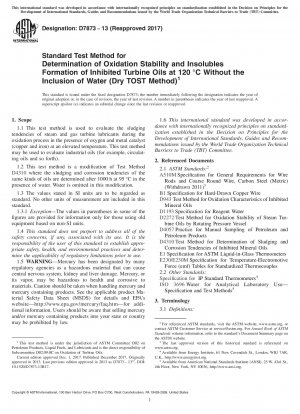ASTM D7873-13(2017)
Standard Test Method for Determination of Oxidation Stability and Insolubles Formation of Inhibited Turbine Oils at 120&x2009;&xb0;C Without the Inclusion of Water (Dry TOST Method)
- Standard No.
- ASTM D7873-13(2017)
- Release Date
- 2013
- Published By
- American Society for Testing and Materials (ASTM)
- Status
- Replace By
- ASTM D7873-20
- Latest
- ASTM D7873-22a
- Scope
-
5.1 Insoluble material may form in oils that are subjected to oxidizing conditions.
5.2 Significant formation of oil insolubles or metal corrosion products, or both, during this test may indicate that the oil will form insolubles or corrode metals, or both, resulting in varnish formation during field service. The level of varnish formation in service will be dependent on many factors (turbine design, reservoir temperature, duty-cycle, for example. peaking, cycling, or base-load duty, maintenance, and so forth) and a direct correlation between results in this test and field varnish formation are yet to be established.
5.3 Oxidation condition at 1208201;°C under accelerated oxidation environment of Test Method D4310 and measurement of sludge and RPVOT value could reflect a practical oil quality in actual turbine operations. Results from this test should be used together with other key lubricant performance indicators (including other established oxidation and corrosion tests) to indicate suitability for service.
1.1 This test method is used to evaluate the sludging tendencies of steam and gas turbine lubricants during the oxidation process in the presence of oxygen and metal catalyst (copper and iron) at an elevated temperature. This test method may be used to evaluate industrial oils (for example, circulating oils and so forth).
1.2 This test method is a modification of Test Method D4310 where the sludging and corrosion tendencies of the same kinds of oils are determined after 10008201;h at 958201;°C in the presence of water. Water is omitted in this modification.
1.3 The values stated in SI units are to be regarded as standard. No other units of measurement are included in this standard.
1.3.1 Exception—The values in parentheses in some of the figures are provided for information only for those using old equipment based on non-SI units.
1.4 This standard does not purport to address all of the safety concerns, if any, associated with its use. It is the responsibility of the user of this standard to establish appropriate safety, health, and environmental practices and determine the applicability of regulatory limitations prior to use.
1.5 WARNING—Mercury has been designated by many regulatory agencies as a hazardous material that can cause central nervous system, kidney and liver damage. Mercury, or its vapor, may be hazardous to health and corrosive to materials. Caution should be taken when handling mercury and mercury containing products. See the applicable product Material Safety Data Sheet (MSDS) for details and EPA’s website—http://www.epa.gov/mercury/faq.htm—for additional information. Users should be aware that selling mercury and/or mercury containing products into your state or country may be prohibited by law.
1......
ASTM D7873-13(2017) Referenced Document
- ASTM A510M Standard Specification for General Requirements for Wire Rods and Coarse Round Wire, Carbon Steel [Metric]
- ASTM B1 Standard Specification for Hard-Drawn Copper Wire
- ASTM D1193 Standard Specification for Reagent Water
- ASTM D2272 Standard Test Method for Oxidation Stability of Steam Turbine Oils by Rotating Pressure Vessel
- ASTM D4057 Standard Practice for Manual Sampling of Petroleum and Petroleum Products
- ASTM D4310 Standard Test Method for Determination of the Sludging and Corrosion Tendencies of Inhibited Mineral Oils
- ASTM D943 Standard Test Method for Oxidation Characteristics of Inhibited Mineral Oils
- ASTM E1 Standard Specification for ASTM Thermometers
- ASTM E230/E230M Standard Specification for Temperature-Electromotive Force (emf) Tables for Standardized Thermocouples
- ISO 3696 Water for analytical laboratory use; Specification and test methods
ASTM D7873-13(2017) history
- 2022 ASTM D7873-22a Standard Test Method for Determination of Oxidation Stability and Insolubles Formation of Inhibited Turbine Oils at 120 °C Without the Inclusion of Water (Dry TOST Method)
- 2022 ASTM D7873-22 Standard Test Method for Determination of Oxidation Stability and Insolubles Formation of Inhibited Turbine Oils at 120 °C Without the Inclusion of Water (Dry TOST Method)
- 2020 ASTM D7873-20 Standard Test Method for Determination of Oxidation Stability and Insolubles Formation of Inhibited Turbine Oils at 120 °C Without the Inclusion of Water (Dry TOST Method)
- 2013 ASTM D7873-13(2017) Standard Test Method for Determination of Oxidation Stability and Insolubles Formation of Inhibited Turbine Oils at 120&x2009;&xb0;C Without the Inclusion of Water (Dry TOST Method)
- 2013 ASTM D7873-13e2 Standard Test Method for Determination of Oxidation Stability and Insolubles Formation of Inhibited Turbine Oils at 120&x2009;&xb0;C Without the Inclusion of Water (Dry TOST Method)
- 2013 ASTM D7873-13e1 Standard Test Method for Determination of Oxidation Stability and Insolubles Formation of Inhibited Turbine Oils at 120deg;C Without the Inclusion of Water 40;Dry TOST Method41;
- 2013 ASTM D7873-13 Standard Test Method for Determination of Oxidation Stability and Insolubles Formation of Inhibited Turbine Oils at 120?deg;C Without the Inclusion of Water 40;Dry TOST Method41;

Copyright ©2024 All Rights Reserved